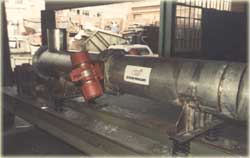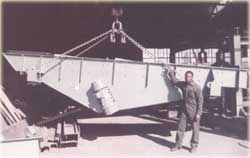Screens & Feeders
|
Karman Vibrating Screens offer one of the largest ranges of Vibrating Screens, Karman Vibrating have developed and designed a wide range of vibrating screens. This provides the user the best screen for the duty. |
|
Extra Heavy Duty BULLDOG Horizontal Screens |
 |
|
|
 |
 |
| BULLDOG Inclined Vibrating Screens | |
|
|
 Karman Sub-Resonant Vibrating Screens Karman Sub-Resonant Vibrating Screens
Karman, SR (Sub-Resonant) vibrating "Screeder" is a combination of a vibrating screen and a vibrating feeder. The Karman Screeder can work under a hopper load thus controlling the material onto the screening surface. In some cases except for "Dewatering" the underpan can be part of the Screeder therefor a cost saving in plant design as well as space saving. |
|
| Karman Adjust-A-Feed Feeder is a "New Generation" |
|
|

producing a long stroke at low frequencies, thus feeding higher feed rates than comparable trough widths found in competitive Feeders. In the design of a natural frequency mechanical Feeder, 2 masses are considered, trough and excitor, connected by means of of a set of steel coil drive springs. A centrifugal force is created by a vibratory motor and this force is magnified by the drive springs causing the trough to vibrate at a long stroke . The major consideration in a natural frequency Feeder is whether to tune above or below resonance and how close to tune to resonance. Equally important are considerations of Hopper design and material head-load, as well as the control of the feed rate. Natural Frequency (NF) It is also interesting to note that dampening factor has an influence on power consumed by or required, to operate a vibratory system. The higher the dampening factor the more energy or kW required to operate the system. The Karman Feeder will not dampen under head-load because of the engineered sub-sesonant design, consider that W1 is subjected to a head-load, which will cause an apparent mass increase and corresponding reduction in system natural frequency to have some significance, we must simultaneously understand MAGNIFICATION FACTOR. Magnification Factor (MF) |
||
| We also design, manufacture and supply: "Brute Force" Vibratory Feeders | ||
 |
 |
|
|
Brute Force Mechanical Vibratory Feeders A simple method to achieve a Linear Stroke is to use two unbalanced motors and run them in Opposite Directions of rotations. The two induction motors synchronise themselves automatically on the bases of mass effect principles. As with magnetic drive, the unbalanced motors are arranged in such a way that is direct upwards at a selected angle of attack |
||
